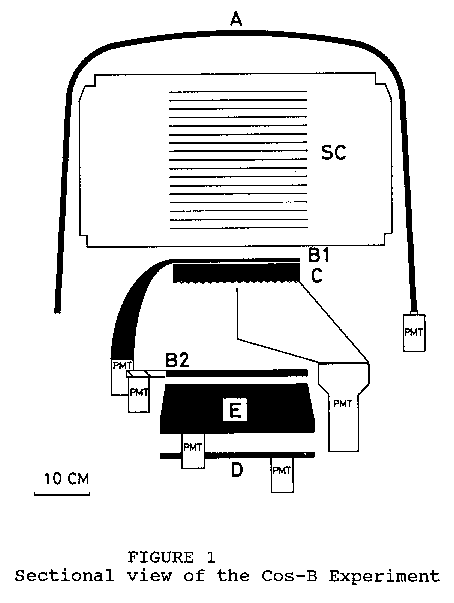Gamma Ray Telescope - COS-B
The Gamma-Ray Telescope
Cos-B carried a single large experiment, the design and provision of which have been the responsibility of a group of research laboratories known as the Caravane Collaboration. The experiment has been described in detail by Bignami et al.( Ref.1).
The gamma-ray detector features a magnetic-core, wire-matrix spark chamber, SC, triggered by a three-element (B1, B2, C) scintillation counter telescope. For gamma-ray selection a plastic scintillator guard counter (A) surrounding these two units is placed in anti-coincidence to reject triggers due to incident charged particles. Beneath the telescope is an energy calorimeter (E) consisting of a caesium iodide scintillator which absorbs the secondary particles produced by the incident photons.
The essential parameters for the measurement of gamma rays incident parallel to the experiment axis are shown as functions of energy in Figure 2. The values given are those appropriate to the stringent conditions for event selection which are applied to the flight data in order to improve the signal/noise ratio. The effective sensitive area reaches a maximum value of about 50 cm² at around 400 MeV. The angular resolution is given as the FWHM of the spatial angular resolution or point-spread function, which best describes the experiment's capability to resolve two neighbouring point sources. It decreases asymptotically to about 2 deg at high energies. The energy resolution has its best value (~40% FWHM) at about 150 MeV and is better than 100% up to at least 3 GeV. All these parameters degrade with increasing angle of incidence. The sensitive area falls to zero at an angle of about 30 deg. Most of the results published have been derived from measurements within 20 deg of the axis-pointing direction.
Alongside the gamma-ray detector is mounted a proportional counter, sensitive to 2-12 keV X-rays, to provide synchronisation for possible short-period pulsations of gamma-ray emission from X-ray pulsating sources. The pulsar synchroniser has also been used for monitoring the intensity of radiation from X-ray sources. I will not dwell on this but refer you to the numerous papers on this subject by Michiel van der Klis and colleagues, an example of which is presented in these proceedings on the subject of Cygnus X-3.
- Removed a total of (3) align=center.








































 Sign in
Sign in
 Science & Technology
Science & Technology

